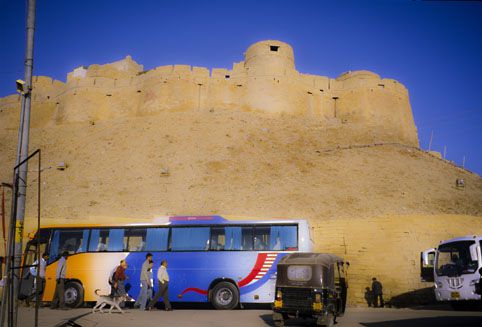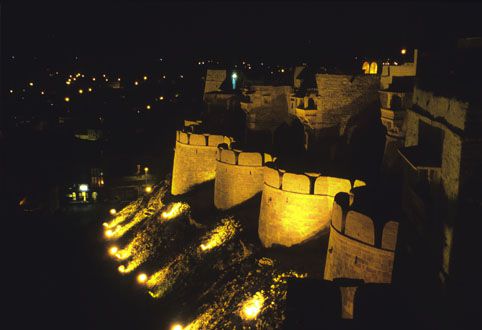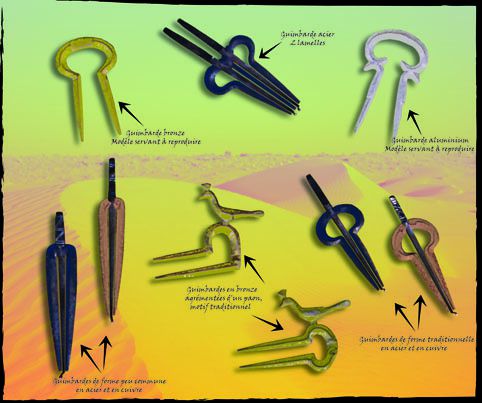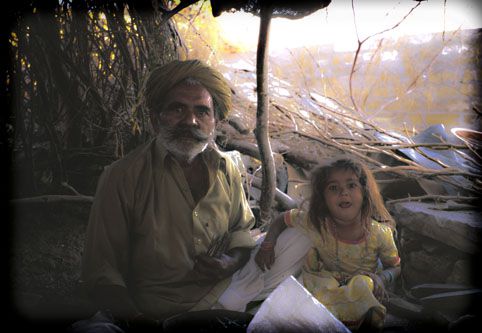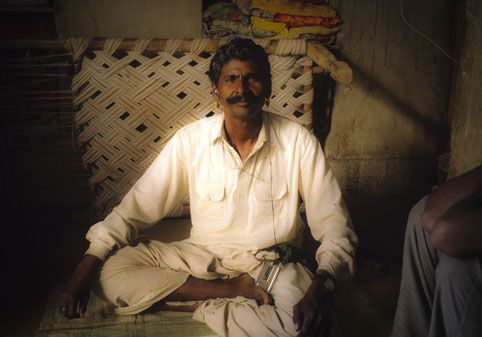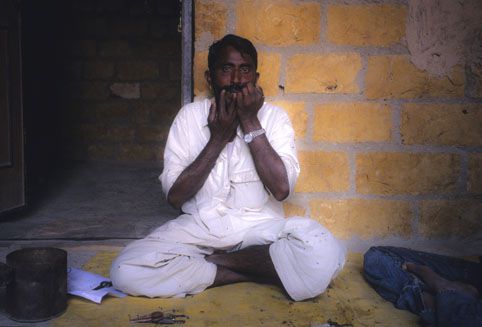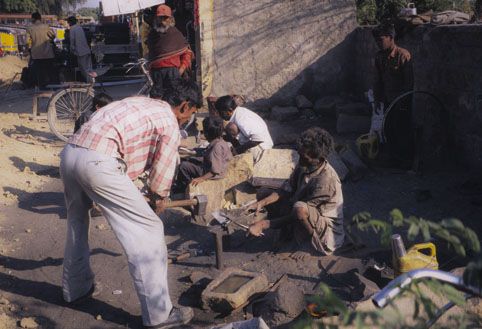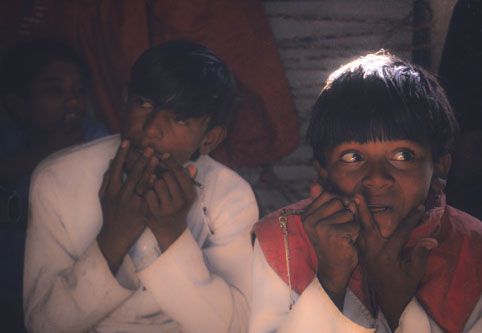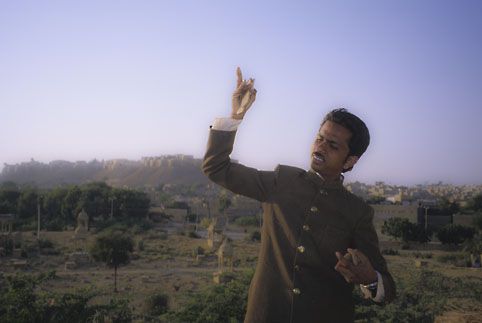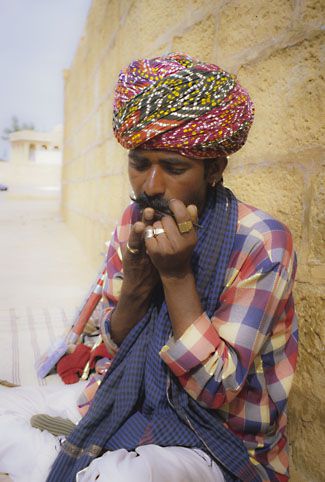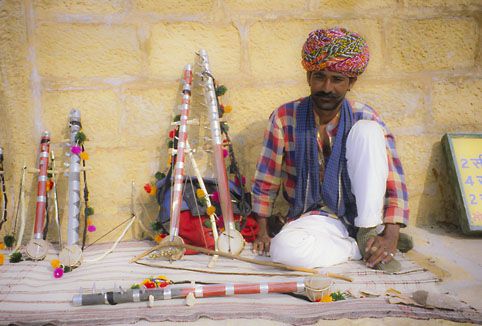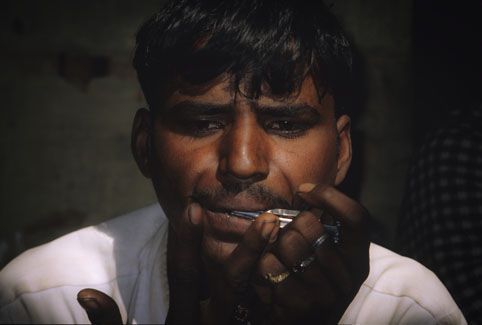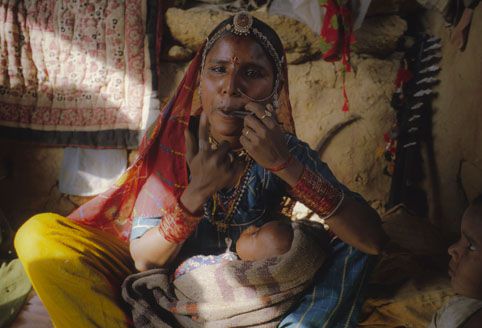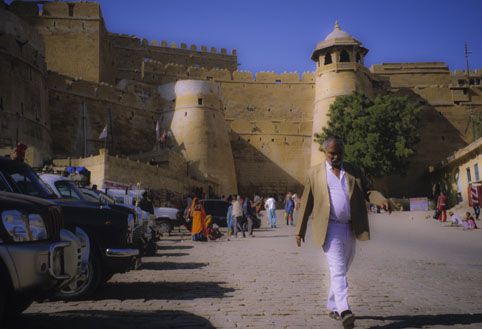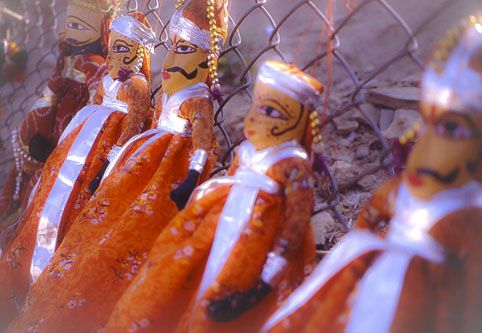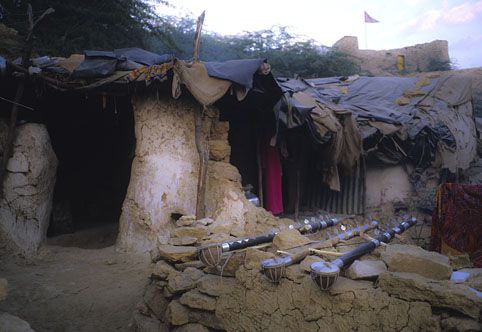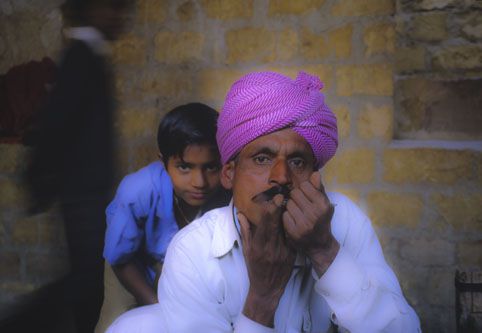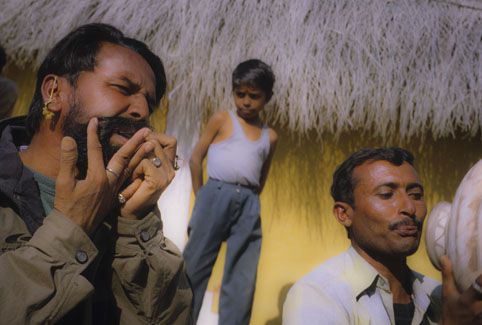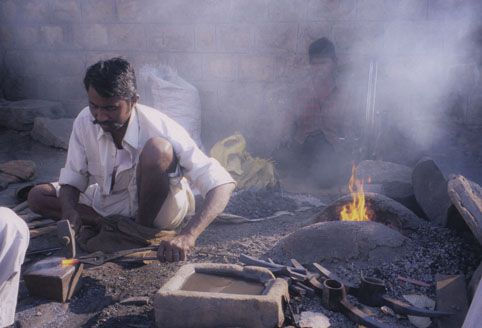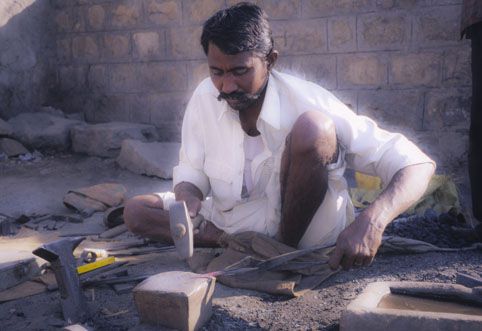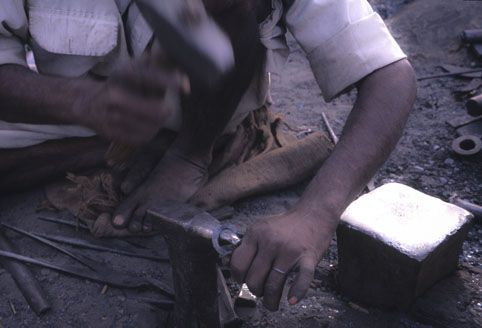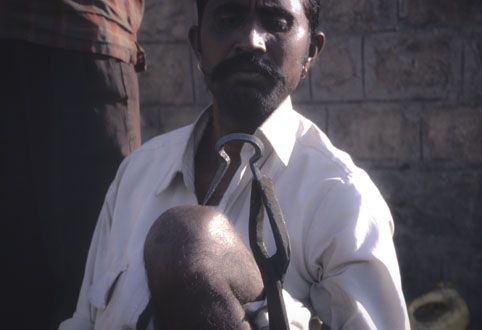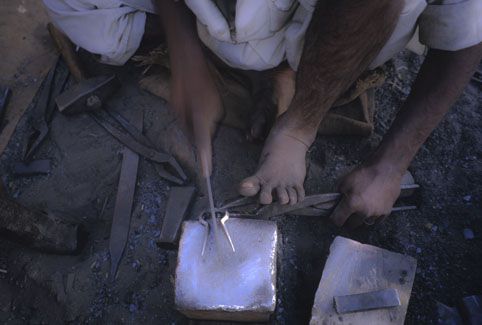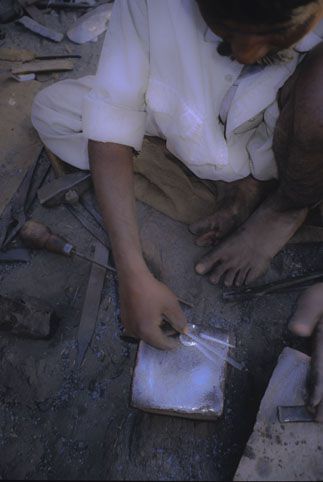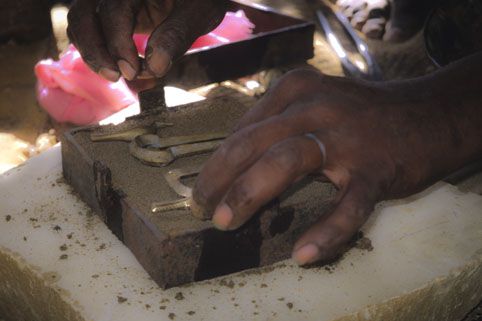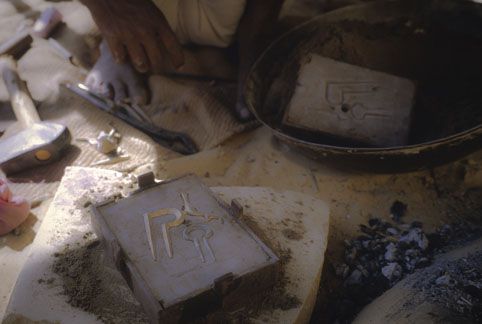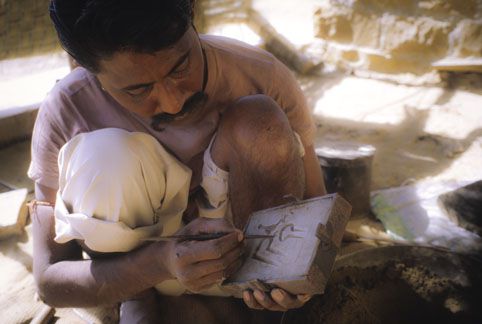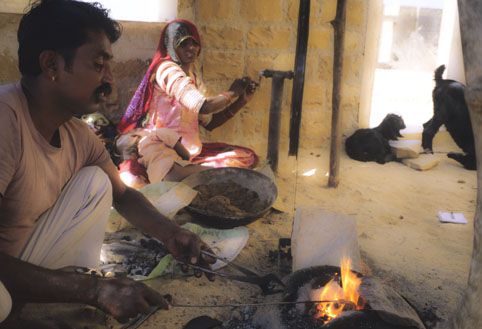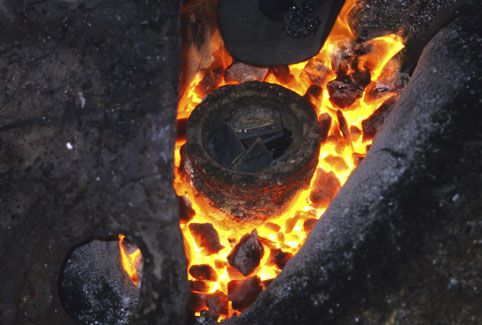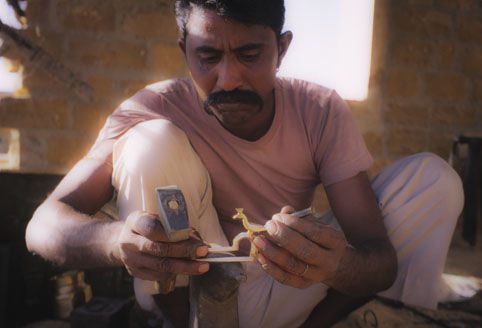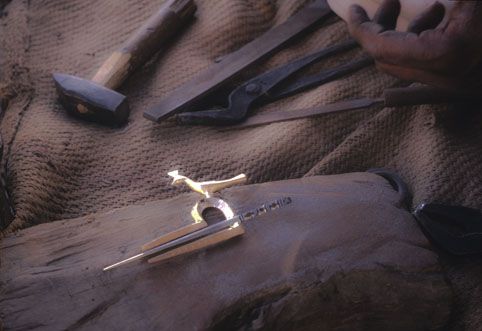14 chansons dans la poussière /// 14 songs in the dust
Voici environ 5 ans, voyageant au Rajasthan j'ai bloqué 7 semaines à Jaisalmer. J'y ai découvert un instrument sublime aux modulations aériennes envoûtantes. J'ai passé du temps à en apprendre sur cet instrument, à rencontrer les différentes castes qui en pratiquaient et à essayer désespérement d'en jouer. Résultat : ils m'ont viré de la ville, blacklisté à vie, hahahahaha. Voici donc deux reportages, l'histoire de cet instrument à Jaisalmer jusqu'en Norvège, ainsi qu'un autre petit reportage qui vous apprendra comment couler (aluminium et laiton) ou forger (acier et cuivre) une guimbarde rajasthanaise appelé ici MORCHANG.
J'ai aussi monté un groupe appelé "Jati connection" avec des personnes de différents groupes sociaux et enregistré 15 heures de ces rencontres. En est né un CD appelé "14 chansons dans la poussière" que je passe de temps en temps sur le blog (la première chanson est un hommage à la déesse Saraswati, déesse de la connaissance et des arts). En espérant que vous puissiez synchronisé la lecture et l'écoute. Si jamais vous n'arriviez jamais à tomber sur la lecture de cet album, n'hésitez pas à me demander de le passer. Si j'en ai la possibilité sur le moment je le ferai avec plaisir.
About 5 years ago while travelling through Rajasthan I got stock in Jaisalmer 7 weeks. I have discovered a wonderful music instrument with captivating aerial modulations. I spent time to learn about this instrument, spent time meeting the different social groups playing it and spent time trying desperately playing it. Result : I got sacked from the city, blacklisted for life hahahahaha. So here are two reportages, the history of this instrument in Jaisalmer as well as elsewhere, and also a reportage about how to cast (aluminium and brass) or to forge (iron and copper) a rajasthani jew harp here called MORCHANG.
I also created a band called "Jati connection" with guys from different social groups and recorded them for about 15 hours then created a CD called "14 songs in the dust" that I play sometimes on the blog (the first track is a tribute to the goddess Saraswati, goddesss of knowledge and arts). Hope you can synchronised the reading and the listening. If you don't get the music whenever you try, then don't hesitate asking me to play it someday. If I can I will.
Photo 1 : Fort de Jaisalmer / Jaisalmer night
Photo 2 : Jaisalmer de nuit / Jaisalmer night
1ère partie / 1st part
Morchang guimbarde du Rajasthan / Morchang jew harp from Rajasthan
photo 03 : Guimbardes / Jew harp
Le train progresse avec nonchalance dans un décor désertique où quelques arbres sont en mode « survie ». Il traverse le désert du Thar, à l’ouest de l’Inde dans l’état du Rajasthan, direction la « cité dorée », Jaisalmer, une des Mecque mondiale de la guimbarde (photos 01 & 02). Le train a quitté Jodhpur « la ville bleue », puis, une paire de chaïs (fameux thé au lait) plus tard apparaît un château de sable posé sur un promontoire aride et sans végétation : Jaisalmer, cité séculaire, caravansérail rescapé du temps qui passe, affiche sa puissance minérale, ses murailles épaisses agrémentées de quatre-vingt-dix-neuf bastions couronnent le mont Trikuta. La cité intra-muros est un dédale de ruelles agitées, parcourues de vie et de vaches, images pittoresques sur fond de ciel bleu. Mais Dieux (X car nous sommes en terre hindoue) merci, cette ville ne se réduit pas à cette carte postale 3D pour fantasmes d’occidentaux en short.
Approchez-vous, écoutez cette étrange vibration, cette respiration métallique qui monte des faubourgs de la ville. Quelques grammes de métal dont la puissance émotionnelle atteint 10 sur l’échelle de Richter et dont le nom claque dans l’azur : morchang, guimbarde du Rajasthan.
La guimbarde est un instrument vibratoire se scindant en deux catégories :
Les idioglottes lorsqu’elles sont fabriquées d’une seule pièce, en bois, en bambou, en os ou en métal (généralement en laiton).
Les hétéroglottes lorsqu’elles sont composées de deux parties solidarisées, le cadre et la lamelle, appelées aussi l’armature (fixe) et la membrane (qui vibre). (photo 03)
Dans les deux cas une seule note est créée, elle sera modulée par l’effet de la respiration et du mouvement de la langue.
Inconnue en Afrique, en Australie et en Amérique pré-colombienne (ce sont les colons anglais mais aussi des explorateurs espagnols qui l’y ont introduit, sa petite taille en ayant fait un excellent compagnon de voyage ainsi qu’une bonne valeur d’échange), son origine exacte est tout aussi inconnue. L’utilisation du bois et du bambou des modèles idioglottes laisse supposer que la guimbarde aurait migré d’Est en Ouest et qu’elle serait antérieure à l’âge de Fer.
En Europe les fouilles ont mis à jour des guimbardes hétéroglottes du 13ème siècle et aucun indice écrit ou pictural ne l’évoque avant cette période. Aucun modèle idioglotte n’y a jamais été retrouvé, ce qui renforce l’idée d’une migration de l’Est vers l’Ouest. Le musicologue Curt Sachs suggère aussi que la transition bambou - métal se serait effectuée au Nord de l’Inde.
Mais revenons à nos dromadaires.
Au Rajasthan, instrument de solitude, le morchang évoque en notes vibrantes l’histoire immémoriale de la région et de ses habitants, peuple flexible mais cassant. Cet instrument est à l’origine un moyen de s’amuser pour bergers solitaires, aujourd’hui il fait parti du catalogue des instruments traditionnels rajasthanais tout comme l’harmonium, le kamayacha (sorte de guitare jouée comme un petit violoncelle), le dholak (percussion faite d’un fût aux deux extrémités obturées par une peau), les kartals (sorte de castagnettes), le murli (flûte de charmeur de serpent) et les voix claires ou éraillées, puissantes et aériennes.
En ce qui concerne la guimbarde, Jaisalmer et Barmer (153 kms plus au sud) sont les deux principaux centres de fabrication. Barmer produit la quantité alors que Jaisalmer produit la qualité. Dans la « cité dorée » les Lohar (caste des forgerons) sont nombreux, mais peu d’entre eux en fabriquent, néanmoins trois sont incontournables : Gorkha et Mohan Lal Lohar, frères et voisins, ainsi que Ketha Ram Lohar.
En extérieur, sous un toit de branchages enchevêtrés, Gorkha (photo 04) forge toute la journée des guimbardes d’acier de forme basic et traditionnelle. Il ne pourra pas vous les faire chanter : il n’a plus de dents !
Son frère, Mohan Lal (photo 05) en fabrique en acier ou en bronze, dans l’espace ouvert de sa petite cour. Il se fait un plaisir de les essayer pour en extraire un son électrique et fulgurant.
Le troisième Lohar est Ketha Ram (photo 06). Il travaille au bord d’une route congestionnée en périphérie de la ville (photo 07). Respectant les lois du karma (incarnation prenant en compte la somme de ses actions passées) et du dharma (respect de l’ensemble des règles inhérentes à sa caste), Ketha a appris et repris le métier de ses ancêtres. Il forge toute la journée des objets divers, pièces pour véhicules, outils en tous genres mais aussi des guimbardes, savoir non-systématique des Lohar rajasthanais. Il l’a acquis par son père et nous livre en annexe de cet article les étapes de fabrication des morchangs forgées (acier et cuivre) et coulées (bronze et aluminium).
Mais si la seule caste à fabriquer les guimbardes est celle des Lohar, plus nombreuses sont celles à en jouer.
Les Manganyars (voir Hors-série GEO sur les déserts) l’utilisent parfois et sont nombreux à pouvoir en faire sortir le meilleur des sons (photos 08 & 09). Ce sont les seuls à être spécifiquement musiciens-généalogistes de caste, musulmans, attachés au service d’un patron hindou quelque soit sa caste ou son clan. Leur nom signifie « ceux qui mendient », terme péjoratif les reléguant à un statut inférieur au sein de la société jaisalméri. Certains se nomment eux-mêmes « Merasi », mot à l’étymologie arabe dérivé de « miras », « héritage », terme plus valorisant et indiquant leur fonction première, celle d’exécuter les divers chants accompagnant tous rituels au sein des familles hindoues, remémorant à l’assistance la gloire passée et les ascendants illustres de la famille.
Les manganyars sont disséminés sur un territoire allant de zones pakistanaises, Sindh et Baloutchistan, à des zones indiennes à l’ouest du Rajasthan. Dans la région de Jaisalmer, certains membres de cette caste se font appeler « Alamkhane », ce sont ceux attachés au service de la famille royale.
Bien que musulmane, leur identité reste floue, la majorité du groupe se serait convertie à l’Islam vers le 13ème siècle. Du passé ils ont gardé quelques us et coutumes hindoues dont celle de prier la déesse Bhatiyani.
Aujourd’hui, en butte au mercantilisme touristique, les restaurants pour touristes ont remplacés les salons familiaux, et ils y jouent des standards bollywoodiens sauce rajasthanaise, délaissant en partie leur répertoire classique.
Une autre caste concernée par la guimbarde est celle des Bhopa (photos 10 à 12), raconteurs des aventures du dieu-héros rajasthanais Pabuji. Un grand tissu tendu entre deux tiges de bambou dépeint la vie et les évènements majeurs du dieu et les Bhopa en narrent l’histoire, s’accompagnant principalement de leur ravanattha, instrument à cordes constitué d’une demi-noix de coco obstruée d’une peau animale, d’un manche de bambou et de cordes métalliques que l’on fait résonner grâce à un archet agrémenté de grelots. Un joueur de dholak assure la rythmique. Habillées de couleurs vives et de multiples bijoux, les bhopins (femmes des Bhopa) exécutent des danses, tenant en main de petites lampes. Certaines d’entre elles jouent aussi de la guimbarde (photo 13).
A Jaisalmer, ils se croisent aux artères touristiques (photo 14), les hommes jouent et vendent les instruments qu’ils fabriquent, leurs femmes alpaguent les touristes pour vendre des bijoux ou de simples guimbardes de Barmer.
Puis il a la communauté des Bhatt, caste de marionnettistes (photo 15). Le Rajasthan est le lieu de naissance de cet art et les « puppeters » rajasthanais sont connus sous l’appellation de Natas, et il est dit que le premier Nat serait né de la bouche du dieu Brahma.
Plusieurs centaines de familles voyagent de village en village pour jouer leur spectacle et aujourd’hui, dans la « cité dorée » vous les rencontrerez quotidiennement au Desert Cultural Museum. Alors qu’une partie du groupe manipule les marionnettes, l’autre partie joue de la musique et chante les histoires. L’instrument prépondérant est le dholak, parfois accompagné de karthals et exceptionnellement de guimbarde.
A Jaisalmer, tout comme les Manganyars et les Bhopas, les Bhatt vivent pour la plupart dans la Kalakar Colony (la colonie des artistes) (photo 16), enchevêtrement de cases posées sur un flanc de colline un peu trash en périphérie nord de la ville. Et au même titre que leurs voisins directs, les Bhatt participent à la transmission orale d’un savoir et d’une culture ancestrale.
Enfin, de cette liste non-exhaustive, il reste les Bheel (photo 17), dont le nom définit une tribu et non une caste. On les rencontre principalement à l’ouest de l’Inde : Rajasthan, Gujerat, Madhya Pradesh. Dans le passé c’était un groupe nomade, évoluant au gré des saisons et des travaux agricoles à exécuter. Leur période de grâce fut lors de la période pré-British Raj, alors qu’ils étaient de farouches soldats, mercenaires et merveilleux archers qui vendaient leur savoir guerrier aux rajas du coin, dont au très fameux Pratap Singh, Maharana d’Udaïpur, à la fin du 16ème siècle. Aujourd’hui encore l’armée indienne comporte un « Mewar Bhil Corps ».
De nos jours, ils font parti des groupes ethniques défavorisés, vivant principalement d’élevage et de travaux agricoles.
Un instrument leur est particulièrement attaché : l’algoja ou satara, double flûte jouée dans les régions désertiques à l’ouest de l’Inde et à l’est du Pakistan. Un des brillants interprètes actuels est Taga Ram Bheel (photo 18), joueur d’algoja et de guimbarde participant à divers projets nationaux et internationaux et qui se fait accompagner rythmiquement d’un joueur de ghara (simple pot en terre que l’on frappe de ses doigts bagués et dont on tire un son grave lorsque l’on y souffle à l’intérieur).
Le mur des castes est poreux et certains membres d’autres groupes ethniques et sociaux frappent la lamelle avec génie mais, étonnamment, voyagez sans aller bien loin vers le nord, vers le sud, l’ouest ou l’est, aux états limitrophes, le morchang fera alors partie de ces instruments inconnus et étranges, venus d’une autre planète.
Néanmoins, tout au sud de la péninsule indienne vous aurez aussi l’occasion d’en rencontrer sous l’appellation de morsing et au Népal sous celle de murchunga.
Au cas où l’instrument vous intéresse et que vous ayez le désir d’en savoir plus, alors il vous restera quelques dizaines de styles à découvrir et de pays à visiter : Angleterre (jew’s harp ou gewgaw), Norvège (munnharpe), Allemagne et Autriche (maultrommel), Italie (scacciapensieri), Hongrie (doromb), Ukraine (drymba), Russie (vargan), Yakoutie (khomus), Chine (kouxian), Vietnam (dan moi), Philippines (kumbing ou kubing), Bali (genggong), Japon (koukin), …… alors bonnes vacances et bon voyage.
Pour plus d’infos concernant cet instrument voir sur internet :
photo 04 : Gorkha et sa fille / Gorkha and his daughter
photo 05 : Mohan Lal Lohar
photo 06 : Ketha jouant / Ketha playing
photo 07 : Ketha forgeant / Ketha forging
photo 08 : Manganyars jouant du morchang / Manganyars playing the morchang
photo 09 : Imam Deen Khan jouant des karthals / Imam Deen Khan playing karthals
photo 10 : Haris Bhopa jouant du morchang / Haris Bhopa on morchang
photo 11 : Haris Bhopa vendant du ravanathas / Haris Bhopa selling ravanathas
photo 12 : Hanuman Bhopa
photo 13 : Lalta Bhopa jouant du morchang / Lalta Bhopa playing morchang
Photo 14 : Jaisalmer entrée principale / Jaisalmer main gate
photo 15 : Marionettes fabriquées par les Bhatt / Puppets made by the Bhatt
photo 16 : Habitation Bhopa / Bhopa place to live
photo 17 : Ketha Ram Bheel
photo 18 : Taga Ram Bheel
The train is crawling blithely in a desertic landscape where a few trees are in « survival » mode. It goes across the Thar desert, situated west-India in the state of Rajasthan, going towards the « Golden city », Jaisalmer, one of the world Mecca concerning the Jew’s harp (photos 01 & 02). The train left Jodhpur, « The blue city », then, a couple of tchaïs (famous milk tea) later comes to light a sand castle settled on a arid and vegetation free headland : Jaisalmer, ancient city, surviving caravanserai from the time that goes on and on, displays its mineral strenght, its thick walls embellished with ninty-nine bastions crown the Trikuta Hill. The inside of the old fortifications is a maze of small and hectic streets, picturesque images below a cloudless blue sky.
But thank Gods (S because we are in a hindu land), this city doesn’t consist merely of this 3D past-card for tourists in shorts.
Get closer, listen to this weird vibration, this metallic breathing that raises from the suburbs of the city. A few grams of metal that the emotionnal power reaches 10 on the Richter scale and which name cracks in the azure : morchang, jew’s harp from Rajasthan.
The jew’s harp is a vibrating instrument that splits in two categories :
The idioglots when made from a single piece of materal, either wood, bamboo, bones or metal (usually brass).
The hetroglots when made from two separated pieces fixed together, the frame and the flexible metal reed. (photo 03)
In both cases a single note is created, it will be modulated by the effect of the breathing and by the movement of the tongue.
Unknown in Africa, in Australia and in the pre-Columbian America (it’s the british colonists as well as the spanish explorers who introduced it, the jew’s harp small size made of it an excellent travelling companion but also a good exchange value), its exact origin is also unknown.
The use of wood and bamboo of the idioglot jew’s harp suggests that the instrument migrated from East to West, and that it would be prior to the iron age. In Europ, the excavation diggings brought to light some hetroglots jew’s harps from the 13th century, and no written nor pictural clues evoke it before that period of time. And no idioglots instruments have ever been found, reinforcing the theory of a migration from East to West. Curt Sachs, the famous musicologist also suggests that the bamboo to metal transition would have happened North of India.
But let’s come back to our dromedaries.
In Rajasthan, instrument of solitude, the morchang evokes with its vibrating notes the immemorial history of that region and its inhabitants, flexible although snappy people. At first this instrument was a way for the lonely shepherds to have fun, today it’s part of the traditional rajasthani instruments catalogue, just as harmonium, kamachaya (kind of guitar played as a cello), dholak (double-headed hand drum), kartals (kind of castanets), murli (snake-charmer flute) and the crystal clear or rasping voices, powerful and ethereal.
About morchang, Jaisalmer and Barmer (153 kms more south) are the two main places of making. Barmer makes the quantity while Jaisalmer the quality. Within the « Golden city », Lohar people (cast of blacksmith) are in number, but very little of them actually make the instrument, although three of them are key figures : Gorkha and Mohan Lal Lohar, brothers and neighbours, and Ketha Ram Lohar.
Outside, under a tangled branches roof, Gorkha (photo 04) forges all day traditional and basic jew’s harps. He will not be able to make them sing : he has no tooth left !!
His brother, Mohan Lal (photo 05) makes some iron and brass ones, within the space of its small courtyard. He gets pleasure to play them and get a dazzling and electric sound.
The third Lohar is Ketha Ram Lohar (photo 06). He usually works along the congested road on the outskirt of the city (photo 07). Honouring the laws of karma (hindu concept where actions cause the entire cycle of effects in the next incarnation) and dharma (respect of duties due to your cast), Ketha learnt and took over his ancestors’ profession. He forges all day long various things as vehicules parts, any kind of tools but also morchangs, non-systematic knowledge among the Lohar community. He got this knowledge from his father and, provided in the appendix, teach us the step by step of the making of the forged morchangs (iron and copper), and moulded ones (bronze and aluminium).
But if the only one cast to make them is Lohar, many different other play them.
Manganyars use them sometimes and many of them can get the best sound out of morchangs (photos 08 & 09). They are the only ones to be specifically musicians – genealogists by cast, moslem, and attached to the service of a hindu family, whatsoever may be the clan or the cast of these families. Their name means « the ones who beg », pejorative term that relegates them to a lower status within the jaisalmeri society. Some of them call themselves « Mesari », word with an arabic etymology drifted from « miras » meaning « inheritance », word that improves their image, and that tells their real duty : telling through chants and songs during various rituals and occasions of life, the past glory and prestigious ancestors of the landlords or aristocratic families they work for.
Manganyars are spreaded on a vast territory going from pakistani areas, Sindh and Baloutchistan, to indian areas west of Rajasthan. Around Jaisalmer, some of them call themselves « Alamkhane », the ones supported by the royal family.
Although moslem, their identity is blurred, the majority of this group converted to islam around the 13th century. From their past they kept some hindu habits and customs as the one to pray the goddess Bhatiyani.
Today, having to face the touristic mercantilism, fancy restaurants replaced the family houses, so they play bollywoodian standards rajasthani style, leaving behind a big part of their classical songbook.
Another social group concerned by the morchang is the Bhopa (photos 10 to 12), tellers of the adventures of the rajasthani god-hero Pabuji. A wide cloth stretched between two bamboo sticks depicts the life and the major events of the god, and the Bhopa tell the stories, accompanying their words with their usual instrument, Ravanattha. This violin like instrument is made of one half a coconut shut with an animal skin, a neck of bamboo, and some metallic strings that resonate with a bow on which is tighten some small bells. A dholak player manage the rhythm. Dressed with colourful clothes and lots of jewellery, the bhopins (girls among Bhopa community) dance, holding some small oil lamps. Some of them also play morchangs (photo 13).
In Jaisalmer, you can meet them at the main touristic cross roads (photo 14), men playing and selling the ravanatthas that they make, their ladies who nab the tourists, trying hard to sell them jewellery and basic Barmer jew’s harps.
Then comes the Bhatt community, cast of puppeters (photo 15). Rajasthan is the birth place of this art and the members of this social group are often called « Natas ». It is to be said that the first Nat born from Brahma’s mouth.
A few hundreds of families travel from village to village to play their show and nowadays in the « Golden city » you can watch them every day at the Desert Cultural Museum. While a part of the group handle the puppets, the other part play the music and tell stories. The main instrument is dholak, sometimes accompanied with kartals, and exceptionnaly with morchang.
In Jaisalmer, just as manganyars and Bhopa, the majority of the Bhatt community lives in the Kalakar Colony (the artists colony) (photo 16), tangle of huts built on the side of a hill, in the northern part of the city. And just as their fellow neighbours, the Bhatt participate to the oral transmission of an ancient knowledge and culture.
Finally, out of this non-exhaustive list, I would talk about the Bheels (photo 17), who are members of a tribe and not of a cast. You may meet them mainly west-India : Rajasthan, Gujarat, Madhya Pradesh. Once upon a time they were nomadic people, moving according to the seasons and to the agriculture’s schedule. Their grace period happened during the pre-British raj, as they were fierce soldiers, mercenaries and wonderful archers selling their warriors’ skills to some local rajas, and among these rajas was the 16th century Udaipur Maharana : Pratap Singh. Today still the indian army includes a « Mewar Bhil Corps ».
Nowadays, Bheels are part of the underprivileged ethnic groups, mainly making a living from livestock farming or agriculture.
Musically they especially made their own one instrument : algoza or satara (almost same flutes excepted a matter of length), dual flute played in the West of India or in the East of Pakistan. One of the greatest living musician of this is named Taga Ram Bheel (photo 18). He also plays greatly morchang and participates to national and international projects, and is often simply accompanied by a ghara player (ghara is a simple clay pot, the musician uses his fingers, with or without finger rings, his thumbs, his palms and the heels of the hands to strike the outer surface of it, and sometimes also blows air in it to get a low sound).
The cast system is pretty much porous, and some customs move from one to the other, so consequently some members of other groups also hit the reed geniously. Amazingly, travel even short distance towards any direction, you will notice that morchang is one of this unknown and strange instrument, almost alien.
Nevertheless, in the southern dravidian part of India, you may see this instrument called there : morsing, and usually played within the classical register of music and you may see it also in Nepal with a different name : murchunga.
In case you would want to know more about this instrument, you will have tens of styles to discovers, and as many countries to travel to :
England (jew’s harp ou gewgaw), Norway (munnharpe), Germany and Austria (maultrommel), Italy (scacciapensieri), Hungary (doromb), Ukraine (drymba), Russia (vargan), Yakutia (khomus), China (kouxian), Vietnam (dan moi), Philippines (kumbing ou kubing), Bali (genggong), Japan (koukin), …… then enjoy your holidays and bon voyage.
For further informations about this instrument, check this internet page :
2ème partie / 2nd part
Fabrication Guimbarde / The making of Morchang
Morchang forgée
Pour fabriquer une guimbarde en acier, la plus courante, il vous faudra :
-
deux ou trois bons marteaux, une enclume ainsi qu’un tas en acier bien plat.
-
Prendre ensuite une tige métallique d’environ vingt centimètres de long et d’un centimètre de diamètre.
-
La chauffer à la forge. La forge sera creusée dans le sol et enrichie d’un soufflet activé manuellement par un enfant sauvage couvert de suie.
-
La pièce de métal sera ensuite frappée pour en faire un morceau d’acier à quatre faces et aux extrémités en pointe (photos 01 & 02).
-
Le chauffer de nouveau puis courber la partie centrale qui sera ensuite arrondie pour lui donner sa forme traditionnelle (photos 03 & 04).
-
Puis on fabrique la lamelle. Pour cela on prend une plaque d’acier de deux millimètres d’épaisseur environ. On y découpe une lamelle de vingt centimètres de long et de trois millimètres de large.
-
On la chauffe, la frappe, la lime puis la courbe à 90° à l’une de ses extrémités. On obtient la lamelle vibrante qui sera toujours en acier, quel que soit le matériau utilisé pour le corps principal.
-
Retour au corps principal. Dans le fond de la guimbarde, on lime une encoche destinée à enchâsser la lamelle (photo 05) qui sera solidarisée au corps principal (photo 06) par quelques coups de marteau frappés aux angles de l’encoche.
-
Il reste à régler sur le cadre l’écart nécessaire à la vibration de la lamelle d’acier. L’instrument est finalisé en aussi peu de temps qu’il m’a fallu pour écrire ce descriptif. C’est le génie des Lohar, caste des forgerons.
Morchang moulée
Pour mouler une guimbarde en bronze ou en aluminium :
-
il faut tout d’abord prendre un cadre de métal de 4 à 5 centimètres de hauteur que l’on remplira de sable malaxé avec un mélange d’eau et de gaul (sorte de sucre tiré d’un arbre).
-
Puis on tasse le sable à petits coups de marteau avant de saupoudrer la surface avec de la cendre tamisée. On place sur le sable le ou les guimbardes à reproduire que l’on saupoudre aussi de cendre (photo 07).
-
On place alors un deuxième cadre, aux dimensions identiques, sur le premier, et on le remplit à nouveau de ce mélange de sable « sucré » que l’on tasse aussi.
-
On retire ensuite le cadre supérieur pour libérer le ou les guimbardes à reproduire (photo 08).
-
Chaque cadre offre alors l’empreinte d’une moitié d’instrument, empreinte que l’on nettoiera de certaines imperfections à l’aide d’un bâtonnet (photo 09).
-
Ensuite on perce un trou dans le sable du cadre supérieur pour y couler ultérieurement le métal en fusion, puis on resupperpose les deux cadres.
-
Porter le métal à ébullition (photo 10 & 11) puis le couler dans l’orifice.
-
Attendre quelques instants avant de séparer les deux cadres, puis nettoyer la guimbarde de son sable carbonisé avant de la plonger en terre pour qu’elle refroidisse lentement.
-
Lorsqu’elle est froide, on la lime légèrement et superficiellement, puis on la décore à légers coups de marteaux et avec l’aide de poinçons (photo 12).
Les opérations restantes sont les mêmes que pour la guimbarde d’acier : fabrication de la lamelle vibrante en acier, préparation de l’encoche sur le corps principal puis solidarisation (sertissage) de ces deux éléments (photos 13 & 14).
photo 01
photo 02
photo 03
photo 04
photo 05
photo 06
photo 07
photo 08
photo 09
photo 10
photo 11
photo 12
photo 13
photo 14
Forged Morchang
To make an iron morchang, the most common one (the frame could be a copper one too):
1. it needs two or three good hammers, an anvil as well as a flat anvil block.
2. Then take a metallic rod about twenty centimeters long and one centimeter diameter. Heat it in the forge. The forge will be simply made in a hole digged in the ground, enriched with a bellows manually activated by a wild kid covered by soot.
3. Once hot the metallic rod will be hammered to get a four squarred faced rod with pointed extremities (photos 01 & 02).
4. Therefore heat it again, then bend it at its central point and give it a round shape to bring it to its traditional shape (photos 03 & 04).
5. Then we have to make the reed. For that work, take a two millimeters thick iron sheet. Cut a twenty centimeters long by three millimeters wide piece. Heat it, hammer it, file it and bend it to 90° at one of its extremity. You get a vibrating reed that will be in iron, whatsoever is the material used for the frame of the jew’s harp.
6. Back to the frame. At the bottom central part of the jew’s harp, file a notch that will host the reed (photo 05) then secure it to the frame with a few hits of hammer at the angles of the notch (photo 06).
7. All that remains to do now is to adjust the correct space of the frame to allow a perfect vibration of the reed.
The instrument is finished in as little time as I needed to complete that descriptive. That is the genius knowledge of the Lohar, cast of the rajasthani blacksmith.
Moulded morchang
To mould a bronze or an aluminium morchang, firstly you have to :
-
get a 4 to 5 centimeters high metallic rectangular frame that you would fill up with a mixture made of sand mixed up with water and gaul (kind of sugar extracted from a tree).
-
Then press down the sand by hammering it softly before sprinkling one of the surface with sifted ash. After this, place the jew’s harp’s frame to duplicate on the sand, press them softly and sprinkle some more ash (photo 07).
-
Afterward place a second empty identical frame on the top of the first one and fill it up with the same mixture of sand and gaul. Press down tightly.
-
Next, remove the upper frame to free the morchang(s) to duplicate (photo 08). Each frames contains the print of half of the instrument(s), print(s) that you will clean up from tiny imperfections using a stick (photo 09).
-
Make a hole in the sand of the upper frame to pour subsequently the molten metal, then stack the second frame with the other half of the print on top of the first one.
-
Melt the metal (photos 10 & 11) then pour it in the hole.
-
Wait a little while before separating both frames, and clean the morchangs from the charred sand and after that put the instrument(s) under the sandy grounds so they can cool down slowly.
-
Once the jew’s harp is cooled down, file it lightly and superficially, then decorate it a bit with a hammer and different steel punches (photo 12).
-
The next steps are the same than for the forged morchangs : the making of the reed, the filing of a notch and last, the securing of the reed with the bronze or aluminium jew’s harp’s frame (photos 13 & 14).
Vous pouvez acheter ce type de guimbardes sur un site qui en offre un large choix :
You can buy some of these jew harps on this website :
A découvrir aussi
- Dentistes de rue en Inde /// Street dentists in India
- Fly AIR INDIA
- ET TOI, TU L'AS TA MOUSTACHE ? /// AND YOU, DO YOU WEAR YOUR MOUSTACHE ?
Inscrivez-vous au blog
Soyez prévenu par email des prochaines mises à jour
Rejoignez les 89 autres membres

